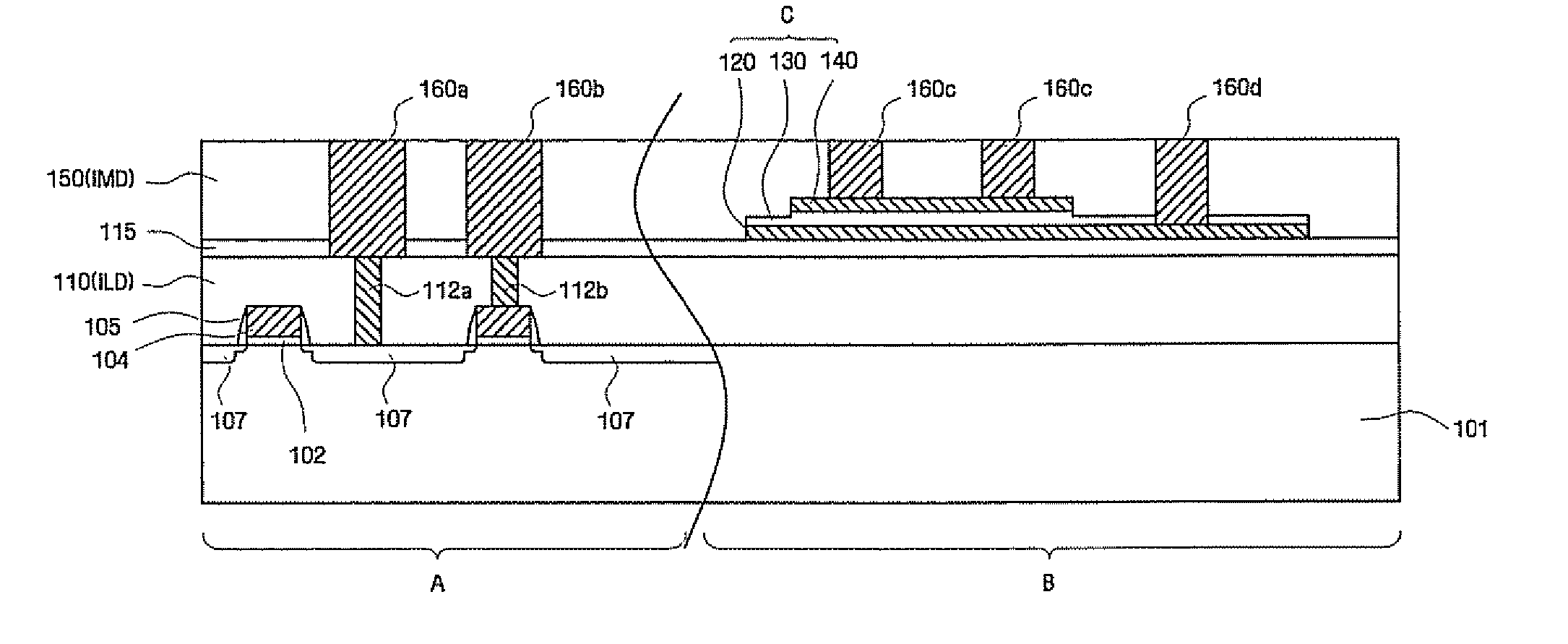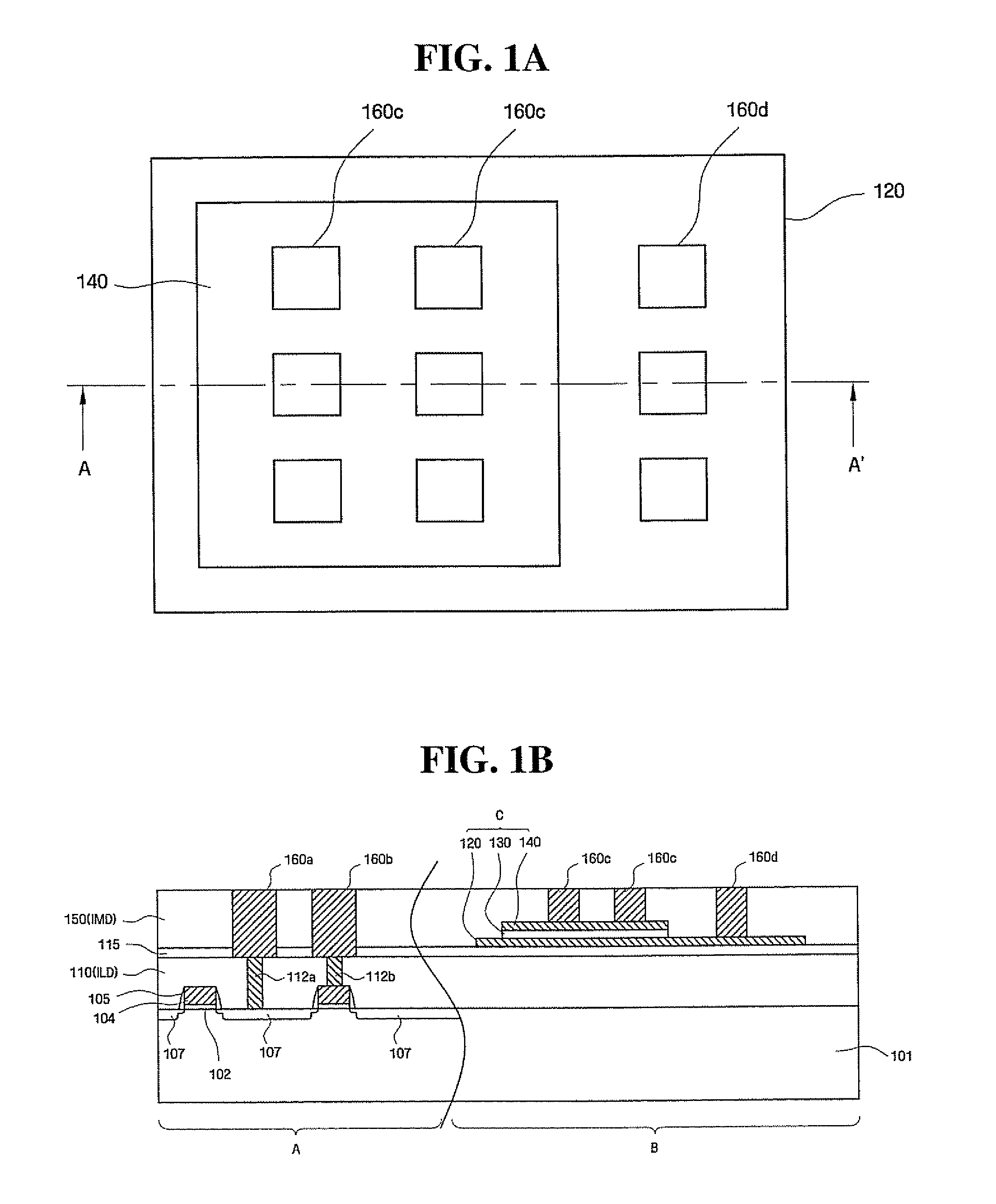Metal-Insulator-Metal (MIM) Capacitors Formed Beneath First Level Metallization and Methods of Forming Same
a technology of metal-insulator metal and capacitors, which is applied in the field of metal-insulator-metal (mim) capacitors and methods of forming same, can solve the problems of metal electrodes, lower mim capacitance, and variation in capacitors, and achieve the effect of improving the leakage current characteristics of capacitor dielectrics
- Summary
- Abstract
- Description
- Claims
- Application Information
AI Technical Summary
Benefits of technology
Problems solved by technology
Method used
Image
Examples
first embodiment
[0021] Referring now to FIG. 1A, an integrated circuit capacitor according to the invention is illustrated as including a lower capacitor electrode 120, an upper capacitor electrode 140 and a plurality of copper damascene interconnect patterns 160c and 106d, which are electrically connected to the upper and lower capacitor electrodes 140 and 120, respectively. As illustrated by FIGS. 1B and 1C, an integrated circuit chip may include a first semiconductor region A and a second semiconductor region B therein. The first semiconductor region A may be a memory cell array region of an integrated circuit memory device and the second region B may be a peripheral circuit region. The first semiconductor region A is shown as including active devices therein. These active devices (e.g., MOS transistors) include insulated gate electrodes (regions 102, 104) with sidewall insulating spacers 105, and source / drain regions 107 of first conductivity type (e.g., N-type) within a semiconductor substrate...
second embodiment
[0024] Referring now to FIGS. 2A-2B, an integrated circuit capacitor according to the invention is illustrated as including a lower capacitor electrode 120, an upper capacitor electrode 140 and a plurality of copper damascene interconnect patterns 160c and 106d, which are electrically connected to the upper and lower capacitor electrodes 140 and 120, respectively. The interconnect patterns 160d illustrated in FIGS. 2A-2B are of larger dimension relative to the interconnect patterns 160d illustrated by FIGS. 1A-1C. As illustrated by FIG. 2B, an integrated circuit chip may include a first semiconductor region A and a second semiconductor region B therein. The first semiconductor region A may be a memory cell array region of an integrated circuit memory device and the second region B may be a peripheral circuit region. The first semiconductor region A is shown as including active devices therein. These active devices (e.g., MOS transistors) include insulated gate electrodes (regions 10...
third embodiment
[0025] Referring now to FIGS. 3A-3B, an integrated circuit capacitor according to the invention is illustrated as including a lower capacitor electrode 120 and an upper capacitor electrode 140 of equivalent dimension. In addition, a semiconductor region 108 of first conductivity type is provided in the substrate 101 and a plurality of electrically conductive vias 112c (e.g., tungsten vias) are provided to electrically connect the semiconductor region 108 to the lower capacitor electrode 120. These vias 112a are provided within openings in the interlayer dielectric layer 110, as illustrated. Based on this configuration, the application of a potential bias (e.g., voltage) to the semiconductor region 108 will be transferred to the lower capacitor electrode 120.
[0026] Referring now to FIGS. 4A-4E, methods of forming the integrated circuit capacitors of FIGS. 1A-1C include forming a plurality of MOS transistors in a memory cell region A of an integrated circuit substrate 101. These MOS t...
PUM
 Login to View More
Login to View More Abstract
Description
Claims
Application Information
 Login to View More
Login to View More - R&D
- Intellectual Property
- Life Sciences
- Materials
- Tech Scout
- Unparalleled Data Quality
- Higher Quality Content
- 60% Fewer Hallucinations
Browse by: Latest US Patents, China's latest patents, Technical Efficacy Thesaurus, Application Domain, Technology Topic, Popular Technical Reports.
© 2025 PatSnap. All rights reserved.Legal|Privacy policy|Modern Slavery Act Transparency Statement|Sitemap|About US| Contact US: help@patsnap.com



